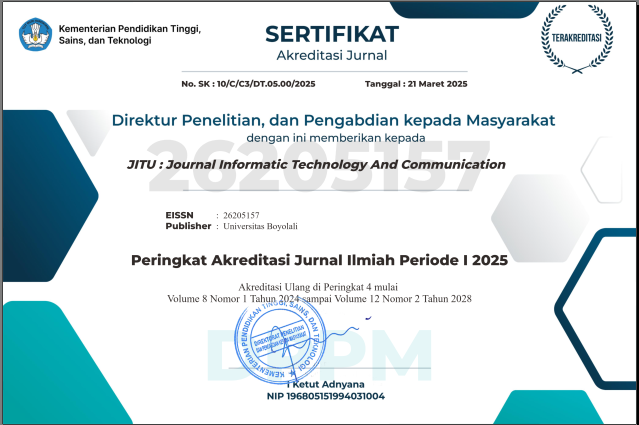Penerapan Metode System Usability Scale untuk Analisis UI/UX Website UMKM Lancar Jaya Food
Keywords:
System Usability Scale, UI/UX, Website, UMKM, Lancar Jaya FoodAbstract
Digitization of Micro, Small, and Medium Enterprises in Indonesia is still not optimal. The lack of full digitalization, besides the HR competency factor, is the unequal distribution of supporting infrastructures such as internet access and transportation. The use of IT in MSMEs is slowly but surely starting to show an increase. Generally, MSME actors use social media as a marketing and promotion medium. In addition to social media, MSMEs have also begun to use the Website as a marketing and promotion medium. However, due to the lack of MSMEs' ability to manage Websites, it is a challenge. As a result, the use of the Website is not optimal and inefficient because orders still use social media such as WhatsApp for buying and selling transactions. The purpose of this study is to analyze the UI/UX of the Lancar Jaya Food MSME Website, especially on the buying and selling features, using the System Usability Scale method. As a result, the System Usability Scale score obtained a value of 73.35, representing Acceptability Ranges with an Acceptable value. Then the adjective rating with a value of Good and Letter Grade with a value of B.
References
[2] A. Halim, “Pengaruh Pertumbuhan Usaha Mikro, Kecil Dan Menengah Terhadap Pertumbuhan Ekonomi Kabupaten Mamuju,” GROWTH J. Ilm. Ekon. Pembang., vol. 1, no. 2, pp. 157–172, 2020, [Online]. Available: https://stiemmamuju.e-journal.id/GJIEP/article/view/39
[3] H. Y. Roida, N. A. Sunarjanto, N. A. Sunarjanto, W. Jayaprana, and W. Jayaprana, “Internasionalisasi Usaha Mikro, Kecil, Dan Menengah (UMKM) Ditinjau Dari Tipe Kepemilikan: Studi Empiris Di Jawa Timur,” J. Manaj. Teor. dan Ter. J. Theory Appl. Manag., vol. 3, no. 2, pp. 158–170, 2010, doi: 10.20473/jmtt.v3i2.2399.
[4] R. J. Naimah, M. W. Wardhana, R. Haryanto, and A. Pebriyanto, “Penerapan Digital marketing Sebagai Strategi Pemasaran UMKM,” J. IMPACT Implement. Action, vol. 2, no. 2, p. 39, 2020, doi: 10.31961/impact.v2i2.844.
[5] M. A. Sanjaya, Y. C. Legono, A. Pranayama, and R. P. Sutanto, “Perancangan Website Animasi Untuk Pembelajaran Matematika Anak Kelas Enam Sekolah Dasar,” J. DKV Adiwarna, vol. 1, no. 18, 2021.
[6] A. R. Setiadi and H. Setiaji, “Perancangan UI/UX menggunakan pendekatan HCD (Human-Centered design) pada website Thriftdoor,” Automata, vol. 1, no. 2, pp. 228–233, 2020.
[7] A. A. Razi, I. R. Mutiaz, and P. Setiawan, “Penerapan Metode Design Thinking pada Model Perancangan Ui/Ux Aplikasi Penanganan Laporan Kehilangan dan Temuan Barang Tercecer,” Desain Komun. Vis. Manaj. Desain dan Periklanan, vol. 3, no. 02, p. 219, 2018, doi: 10.25124/demandia.v3i02.1549.
[8] M. Indra Gunawan, R. Indah Rokhmawati, and N. Hendrakusma Wardani, “Evaluasi dan Perbaikan Antarmuka Pengguna Menggunakan Pendekatan User Centered Design (UCD) dan Card Sorting (Studi Kasus: Website Awake Project Malang),” J. Pengemb. Teknol. Inf. dan Ilmu Komput., vol. 3, no. 5, pp. 4835–4845, 2019, [Online]. Available: http://j-ptiik.ub.ac.id
[9] D. Salsabila, A. Hanifah, and A. Hamid, “Web Based Portfolio sebagai Asesmen Alternatif pada Masa Pembelajaran Daring,” Edukatif J. Ilmu Pendidik., vol. 3, no. 4, pp. 2176–2184, 2021, doi: 10.31004/edukatif.v3i4.897.
[10] N. P. Shita and Yulistiana, “Pengembangan E-Portfolio Fashion Design sebagai Media Personal Branding,” J. Tata Busana, vol. 7, no. 2, pp. 136–141, 2018.
[11] D. Setiawati and T. S. Lestari, “Penerapan Metode UTAUT pada Perilaku UMKM dalam Pemanfaatan Website: Studi Kasus pada CV. Lancar Jaya Food Boyolali,” in Prosiding SEMMAU 2021, 2021, pp. 137–142. [Online]. Available: https://publikasi.uyelindo.ac.id/index.php/semmau/article/view/237
[12] A. R. Bahtiar and M. A. Gustalika, “Penerapan Metode System Usability Scale dalam Pengujian Rancangan Mobile Apps Gamification Tari Rakyat di Indonesia,” J. Media Inform. Budidarma, vol. 6, no. 1, pp. 491–499, 2022, doi: 10.30865/mib.v6i1.3510.
[13] E. C. Shirvanadi and M. Idris, “Perancangan Ulang UI/UX Situs E-Learning Amikom Center Dengan Metode Design Thinking (Studi Kasus: Amikom Center),” Automata, vol. 2, no. 2, 2021.
[14] S. F. Novitasari, Y. T. Mursityo, and A. N. Rusydi, “Evaluasi Pengalaman Pengguna pada E-Commerce sociolla.com Menggunakan Usability Testing dan User Experience Questionnaire (UEQ),” J. Sist. Informasi, Teknol. Informasi, Dan Edukasi Sist. Inf., vol. 1, no. 2, pp. 57–62, 2020, doi: 10.25126/justsi.v1i2.9.
[15] M. A. Yahya, T. Wahyuningrum, and N. A. Prasetyo, “Perancangan Prototype Aplikasi Mobile PlayKids Menggunakan User Experience Lifecycle dan Usability Testing ( USE Questionnaire ),” J. Appl. Comput. Sci. Technol. ( JACOST ), vol. 3, no. 1, pp. 169–178, 2022.
[16] F. H. A. Putro, F. T. Wulandari, and D. Setiawati, “Perilaku dalam Pemanfaatan Communication Technology pada UMKM di Kota Boyolali dengan Pendekatan UTAUT,” Jesya (Jurnal Ekon. dan Ekon. Syariah), vol. 5, no. 1, pp. 827–834, 2022, doi: 10.36778/jesya.v5i1.657.
[17] W. Sanjaya and S. Donna, “Peran E-Commerce dalam Mendukung Peluang Usaha Mandiri pada Masa Pandemi Covid 19 (Studi Kasus UMKM Abon di Kota Boyolali),” Intelektiva J. Ekon. Sos. dan Hum., vol. 2, no. 12, pp. 150–155, 2021, [Online]. Available: https://jurnalintelektiva.com/index.php/jurnal/article/view/665
[18] J. R. Lewis, “The System Usability Scale: Past, Present, and Future,” Int. J. Hum. Comput. Interact., vol. 34, no. 7, pp. 577–590, 2018, doi: 10.1080/10447318.2018.1455307.
[19] S. Borsci, S. Federici, S. Bacci, M. Gnaldi, and F. Bartolucci, “Assessing User Satisfaction in the Era of User Experience: Comparison of the SUS, UMUX, and UMUX-LITE as a Function of Product Experience,” Int. J. Hum. Comput. Interact., vol. 31, no. 8, pp. 484–495, 2015, doi: 10.1080/10447318.2015.1064648.
[20] A. Bangor, P. T. Kortum, and J. T. Miller, “An empirical evaluation of the system usability scale,” Int. J. Hum. Comput. Interact., vol. 24, no. 6, pp. 574–594, 2008, doi: 10.1080/10447310802205776.
[21] A. Bangor, T. Staff, P. Kortum, J. Miller, and T. Staff, “Determining what individual SUS scores mean: adding an adjective rating scale,” J. usability Stud., vol. 4, no. 3, pp. 114–123, 2009.




1.png)









